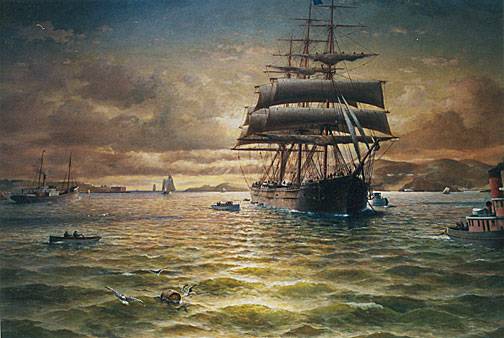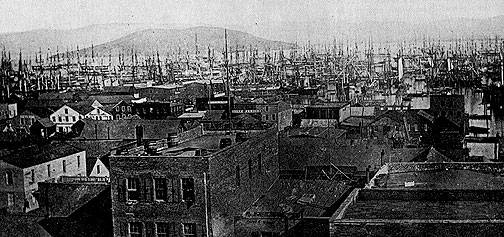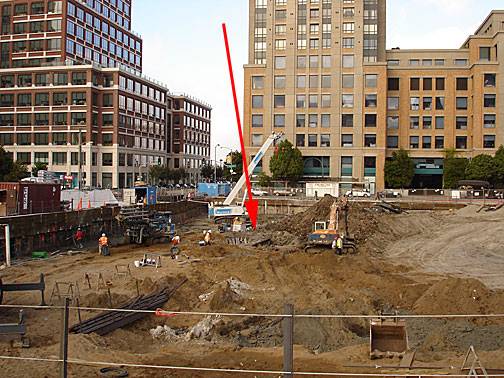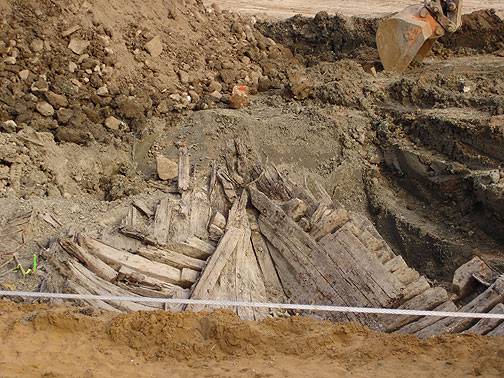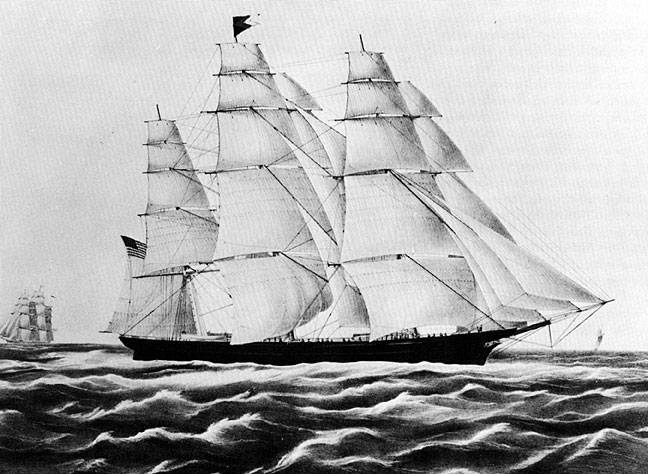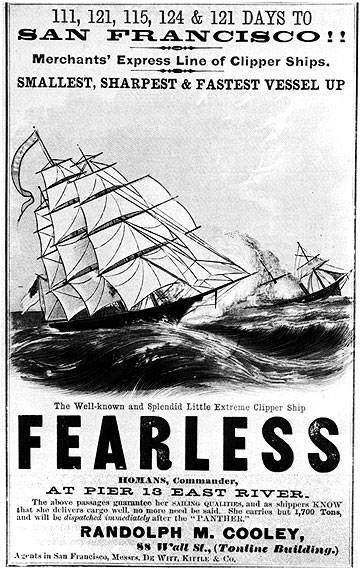Wind Powered Transportation…Back Then: Difference between revisions
(Created page with ''''<font face = Papyrus> <font color = maroon> <font size = 4>Historical Essay</font></font> </font>''' ''by Chris Carlsson'' Image:Coulter-Arrived-All-Well.jpg '''"Arrive...') |
No edit summary |
||
| Line 54: | Line 54: | ||
<blockquote>"Looking round we found ourselves in a rather coarse, and certainly common Battery Point saloon, kept by one Calico Jim, a Chilean as I subsequently learned. (This same gentleman some years later shanghaied six San Francisco policemen sent to arrest him; and was eventually relentlessly followed and shot dead by one of them on the streets of Callao in Chile, South America.) We were about to return outside, not liking the general atmosphere of the place, when a tallish, high-cheeked, square-jawed adder-eyed, raw type of man arrested us with his silvery-toned voice: | <blockquote>"Looking round we found ourselves in a rather coarse, and certainly common Battery Point saloon, kept by one Calico Jim, a Chilean as I subsequently learned. (This same gentleman some years later shanghaied six San Francisco policemen sent to arrest him; and was eventually relentlessly followed and shot dead by one of them on the streets of Callao in Chile, South America.) We were about to return outside, not liking the general atmosphere of the place, when a tallish, high-cheeked, square-jawed adder-eyed, raw type of man arrested us with his silvery-toned voice: | ||
<br><br> | |||
''Say, yoo two, ef yer want a lonesome conversassy, jest vamoos inter thet er room there. (He indicated a door at the opposite end.) Yooll sure be all possum in there . . . out of the bar-room heat and thet. . . . Jest ring fur yer poisons.'' | ''Say, yoo two, ef yer want a lonesome conversassy, jest vamoos inter thet er room there. (He indicated a door at the opposite end.) Yooll sure be all possum in there . . . out of the bar-room heat and thet. . . . Jest ring fur yer poisons.'' | ||
<br><br> | |||
We sat down in that chair-spangled fatal room. Really it proved refreshingly cool; and through the window overlooking the harbour I noticed in the fading evening light several large and graceful sailing-ships: some deeply laden and at rest as if cut in cameo, whilst others, quite light, with their yards already cock-billed, were evidently preparing to proceed immediately up the Sacramento River to Crockett or Port Costa to obtain their grain cargoes for Europe."</blockquote> | We sat down in that chair-spangled fatal room. Really it proved refreshingly cool; and through the window overlooking the harbour I noticed in the fading evening light several large and graceful sailing-ships: some deeply laden and at rest as if cut in cameo, whilst others, quite light, with their yards already cock-billed, were evidently preparing to proceed immediately up the Sacramento River to Crockett or Port Costa to obtain their grain cargoes for Europe."</blockquote> | ||
| Line 68: | Line 66: | ||
[[category:Transit]] [[category:1850s]] [[category:1860s]] [[category: | [[category:Transit]] [[category:1850s]] [[category:1860s]] [[category:1823-1846]] | ||
Latest revision as of 23:02, 10 August 2011
Historical Essay
by Chris Carlsson
"Arrived All Well" by William Coulter (1909) is a painting that hung in the Merchant Exchange over the chalkboards that indicated what cargoes were arriving on which ships. The title is the tagline for any ship-and-cargo that arrived safely. If you look closely you can see, ranged along the yardarms that branch out from the ship's main mast, more than a hundred dizzying feet above the deck, tiny men furling the heavy canvas sails after months of sea and wind.
Photo: David Green
Most of us in 21st century San Francisco are firmly terrestial. We got here in a car, on a bus, a plane, or rarely now a train. Part one took a look at walking across the sand dunes that once dominated the landscape.
Today, we look at the experience of travelling by sailing ship, which is how most of the early San Franciscans arrived. Arrival by ship was the main option until after 1869, when the transcontinental railroad opened. Ship transit continued as a common experience until well into the 20th century. It really wasn't until after World War II that transoceanic travel left the seas in favor of the skies. Who knows, maybe it'll be back again soon, challenging us to overcome our landlubber status!
There had already been a steady ocean-going trade across the Pacific for two centuries before the San Francisco Bay became a participant. Manila galleons carried goods between Mexico and the Philippines, Spanish colonies during the 1500s and 1600s (it's a little known fact that Filipinos were among the first to arrive in California, long before the Gold Rush). By the time Mission Dolores was being founded in the Spanish territory of Alta California, and the United States won its independence from England, American merchants were aggressively entering the world shipping business. Ships flying the stars and stripes were soon calling at ports in the West Indies, China, and India, not to mention leading the industrial exploitation of the largest mammals in the sea, the whales.
The Mission economy, based primarily on trade in cow hides and tallow, was supplemented by the first great slaughter on the west coast that decimated the native sea otter population between the late 1700s and the 1840s. Richard Henry Dana was a sailor in that era, and colorfully describes his experience in the San Francisco Bay in 1835 in his classic "Two Years Before the Mast."
"Here, at anchor, and the only vessel, was a brig under Russian colors, from Sitka, in Russian America, which had come down to winter, and to take in a supply of tallow and grain, great quantities of which latter article are raised in the missions at the head of the bay. The second day after our arrival, we went on board the brig, it being Sunday, as a matter of curiosity; and there was enough there to gratify it. Though no larger than the Pilgrim, she had five or six officers, and a crew of between twenty and thirty; and such a stupid and greasy-looking set, I certainly never saw before. Although it was quite comfortable weather, and we had nothing on but straw hats, shirts, and duck trowsers, and were barefooted, they had, every man of them, doublesoled boots, coming up to the knees, and well greased; thick woolen trowsers, frocks, waistcoats, pea-jackets, woolen caps, and everything in true Nova Zembla rig; and in the warmest days they made no change. The clothing of one of these men would weigh nearly as much as that of half our crew. They had brutish faces, looked like the antipodes of sailors, and apparently dealt in nothing but grease. They lived upon grease; eat it, drank it, slept in the midst of it, and their clothes were covered with it. To a Russian, grease is the greatest luxury. They looked with greedy eyes upon the tallow-bags as they were taken into the vessel, and, no doubt, would have eaten one up whole, had not the officer kept watch over it. The grease seemed actually coming through their pores, and out in their hair, and on their faces. It seems as if it were this saturation which makes them stand cold and rain so well. If they were to go into a warm climate, they would all die of the scurvy."
Yerba Buena Cove in 1851, a forest of masts, many of them on ships that had been scuttled and sunken into the mud of the cove (today's Financial District).
Starting with the 1848 Gold Rush, thousands of people arrived in San Francisco from across the seas. The new port was soon a forest of masts as sailors and passengers alike abandoned ship and took off for the gold country. This in turn gave rise to an industry of labor "recruiting" in San Francisco known as "crimping," which gained the better-known moniker for those who were thus recruited of being "Shanghaiied." Finding sailors for ships through trickery, bribery, and force was a thriving business in San Francisco all the way into the 20th century. In fact, it was not made illegal until a federal prohibition was signed by President Teddy Roosevelt in 1906, and then didn't fully disappear until after the LaFollette Act of 1915 imposed new regulations on Maritime Employment, and commercial sailing vessels were phased out during WWI. Prior to these progressive reforms in the 20th century, courts repeatedly upheld the rights of ship owners and ship captains to control anyone who was on board as an "employee." An 1897 decision of the U.S. Supreme Court (Robertson v. Baldwin) held that "seamen are ... deficient in that full and intelligent responsibility for their acts that is accredited to ordinary adults, and [need] the protection of the law in the same sense in which minors and wards are entitled to the protection of their parents and guardians," concluding that sailors had to be protected from themselves and were not subject to the 13th Amendment's prohibition of involuntary servitude!
The 1830 ship the Candace was discovered as the Millennium Towers were being built a couple of years ago at Main and Folsom. After a pause for an archeological analysis, the crews dug down four stories further to build the enormous foundation they hope will survive future earthquakes!
The Candace's prow
Photos: Chris Carlsson
The sudden rapid development of San Francisco as a world port thanks to the Gold Rush gave a huge boost to the sailing ships of the era. The Clipper Ships that dominated world trade during the mid-19th century were developed to meet the radically increased demand for goods and passenger service between the east coast, San Francisco, and China. Ships crossed the Pacific Ocean from China, the Philippines, Chile, and Australia, while French, Germans, English, and Americans made their way on great sailing ships around the Cape Horn in terrifying journeys that often ended in shipwreck and death. Early steam ships that made the arduous journey to San Francisco became profitable immediately. The Clipper ships too were enormously profitable for their owners, since no serious cargo could travel across the isthmus. The Clippers employed a dizzying array of sails that made up as much as an acre and a half of canvas, known as spanker sails, spencer sails, jibs, topsails, skysails, royal studdingsails, and moonsails and more. Thanks to rapidly advancing hull designs they were able to shorten travel time between the northeast and San Francisco to less than 100 days, while carrying heavy equipment, machinery, houses, large quantities of furniture, and bulk merchandise. In the first year of use a typical Clipper would make up to $50,000 above their building cost, and a speedy captain could make $3000 for a trip, with a bonus up to $5000 if he made it in under 100 days.
The Flying Cloud was one of the record-breaking Clipper ships that made the journey from the east coast to San Francisco in 89 days.
The "extreme clipper" Fearless was launched in Boston 1853. Small, elegant, and fast, it averaged 125 days from Boston to SF.
The 1850s was also the era in which steam ships were emerging to supplant the long dependence on wind and sail, but for the rest of the 19th century, sail power remained an important component of ocean-going travel. Passengers leaving New York or Boston on Clipper ships hoped for a quick journey, meaning they would make it safely to the far-off port of San Francisco in 4 months or less. Others made their way on east coast steam ships or a panoply of forgotten vehicles -- scows, schooners, whaleboats, and other floating craft -- along the coast into the Caribbean and to New Orleans. From there they proceeded to the port city of Aspinwall (now Colón), for the difficult trans-isthmus journey through Panama (then part of Colombia, or as it was known at the time, the Republic of New Granada). A railroad across the isthmus was under construction already in 1850 in response to the surge of demand to travel to California for the Gold Rush. But after disembarking at the port travelers depended mostly on native dugout boats to take them up the wild Chagres River, and then after crossing the Continental Divide, they finished the journey on foot or by mule for the last 20 miles over old, decrepit Spanish trails.
Water-based travel had many decades to go before giving way fully to rail, and then truck and automobile. But the lore of the sea still holds our imaginations, romantically for some, horrifying for others. Herman Melville's incredible classic "Moby Dick" is imposed on many of us in our high school years, and that's a pity because it's a book better digested at an older age. In it he describes a remarkable multiracial onboard culture of sailing life, the hellish brutality and barbarism of life at sea, and the conditions of the sailors (workers) on the floating industrial processing plants that were whaling ships in the 19th century. There's a rich lore of stories that imbue waterfront dives and creaking timbers with salty memories that today we can only consume vicariously. The questions of historiography, how we know what we know about the past, are raised by the largely anecdotal accounts of sea passage from that long-ago era.
In her essay "About that Blood in the Scuppers" (in Reclaiming San Francisco: History, Politics, Culture; City Lights Books, San Francisco: 1998) Georgia Smith takes this issue head-on with some compelling examples:
Much of the waterfront's past is revealed only in anecdotes, or more broadly, anecdotal sources, by which I mean accounts that make a particular moment vivid by telling a funny story (or an outrageous or a grotesque one), or revealing an evocative detail, or indulging in an emotional outburst. One afternoon in the 1890s, Hiram Bailey and his friend Ben (neither one a sailor) went into a dive down on the waterfront:
"Looking round we found ourselves in a rather coarse, and certainly common Battery Point saloon, kept by one Calico Jim, a Chilean as I subsequently learned. (This same gentleman some years later shanghaied six San Francisco policemen sent to arrest him; and was eventually relentlessly followed and shot dead by one of them on the streets of Callao in Chile, South America.) We were about to return outside, not liking the general atmosphere of the place, when a tallish, high-cheeked, square-jawed adder-eyed, raw type of man arrested us with his silvery-toned voice:
Say, yoo two, ef yer want a lonesome conversassy, jest vamoos inter thet er room there. (He indicated a door at the opposite end.) Yooll sure be all possum in there . . . out of the bar-room heat and thet. . . . Jest ring fur yer poisons.
We sat down in that chair-spangled fatal room. Really it proved refreshingly cool; and through the window overlooking the harbour I noticed in the fading evening light several large and graceful sailing-ships: some deeply laden and at rest as if cut in cameo, whilst others, quite light, with their yards already cock-billed, were evidently preparing to proceed immediately up the Sacramento River to Crockett or Port Costa to obtain their grain cargoes for Europe."
Did someone really dupe (or dope) six cops, all at once, put them on a ship, and get away with it? Was the man who spoke to Bailey really high-cheeked, square-jawed, and adder-eyed? A rich vein of unreliable history is mined by guys sitting around getting drunk, telling each other lies—which, however, are slathered onto a base of truth. Calico Jim figures in shanghaiing lore, and though his authenticity is disputed, his profession was real:He was a crimp, one who made a living by delivering men—via persuasion, trickery, or force—to sailing ships in need of crew.
The infamously difficult passage around the Cape Horn at the southern tip of South America, a journey that could take a month or more just to go from the Atlantic to the Pacific into the teeth of howling icy winds, is far removed from our contemporary ability to cross half the planet in less than a day. Spending four or more months at sea, stuffed into stinking fo'c'sle's full of rotting food, human waste, vomit, and disease, all to reach a new life in a new land, is hard to imagine in its minute-by-minute misery.
Or working on ships for years at a time, climbing masts in gale force winds, prying at ropes and sails caked in thick ice, while trying not to fall to your death in violent seas. But people did it—almost routinely—for decades. Those who survived those perilous journeys often stayed and became the early Californians who shaped the culture at the edge of the continent, freed from the expectations and burdens and cultural norms that they'd left behind, for better and worse.

